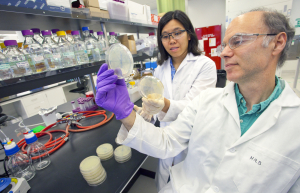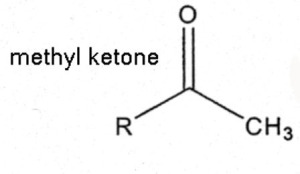
Methyl ketones were discovered more than a century ago in the aromatic evergreen rue plant. They are now used to provide scents in essential oils and flavoring in cheese, but JBEI research shows they could also serve as advanced biofuels. (Image from Wikimedia Commons)
Two years ago, researchers at the U.S. Department of Energy’s Joint BioEnergy Institute (JBEI) engineered Escherichia coli (E. coli) bacteria to convert glucose into significant quantities of methyl ketones, a class of chemical compounds primarily used for fragrances and flavors, but highly promising as clean, green and renewable blending agents for diesel fuel. Now, after further genetic modifications, they have managed to dramatically boost the E.coli’s methyl ketone production 160-fold.
“We’re encouraged that we could make such a large improvement in methyl ketone production with a relatively small number of genetic modifications,” says Harry Beller, a JBEI microbiologist who led this study. “We believe we can further improve production using the knowledge gained from in vitro studies of our novel metabolic pathway.”
Beller, who directs the Biofuels Pathways department for JBEI’s Fuels Synthesis Division, and is also a senior scientist with Berkeley Lab’s Earth Sciences Division, is the corresponding author of a paper describing this work in the journal Metabolic Engineering. The paper is titled “Substantial improvements in methyl ketone production in E. coli and insights on the pathway from in vitro studies.” Co-authors are Ee-Been Goh, Edward Baidoo, Helcio Burd, Taek Soon Lee and Jay Keasling.
Methyl ketones are naturally occurring compounds discovered more than a century ago in the aromatic evergreen plant known as rue. Since then they’ve been found to be common in tomatoes and other plants, as well as insects and microorganisms. Today they are used to provide scents in essential oils and flavoring in cheese and other dairy products. Although native E. coli make virtually undetectable quantities of methyl ketones, Beller, co-author Goh and their colleagues have been able to overcome this deficiency using the tools of synthetic biology.

The research of Harry Beller (foreground) and Ee-Been Goh of the Joint BioEnergy Institute is boosting the production of methyl ketones by engineered strains of E.coli. (Photo by Roy Kaltschmidt, Berkeley Lab)
“In our original effort, for methyl ketone production we made two major modifications to E. coli,” Beller says. “First we modified specific steps in beta-oxidation, the metabolic pathway that E. coli uses to break down fatty acids, and then we increased the expression of a native E. coli enzyme called FadM. These two modifications combined to greatly enhance the production of methyl ketones.”
In their latest effort, Beller, Goh and their colleagues made further modifications that included balancing the overexpression of two other E. coli enzymes, fadR and fadD, to increase fatty acid flux into the pathway; consolidating two plasmid pathways into one; optimizing codon usage for pathway genes not native to E. coli; and knocking out key acetate production pathways. The results led to a methyl ketone titer of 3.4 grams/liter after approximately 45 hours of fed-batch fermentation with glucose. This is about 40-percent of the maximum theoretical yield for methyl ketones.
“Although the improved production is still not at a commercial level in the biofuel market, it is near a commercial level for use in flavor and fragrances, where certain methyl ketones are much more highly valued than they would be in the biofuel market,” Beller says. “It may be possible for a company to sell a small percentage of methyl ketones in the flavor and fragrance market and use the profits to enhance the economic viability of the production of methyl ketones as biofuels.”
The in vitro studies carried out by Beller and Goh provided insights into the pathway, some of which point to even further production gains. One key finding was the confirmation that a decarboxylase enzyme is not required for this methyl ketone pathway.
 “Several different metabolic pathways have been developed in the past couple of years for methyl ketone production in E. coli, a couple of which use decarboxylase enzymes to catalyze the last step of the pathway,” Beller says. “Our methyl ketone pathway is performing quite a bit better than these other pathways, but it does not include a native or added decarboxylase.”
“Several different metabolic pathways have been developed in the past couple of years for methyl ketone production in E. coli, a couple of which use decarboxylase enzymes to catalyze the last step of the pathway,” Beller says. “Our methyl ketone pathway is performing quite a bit better than these other pathways, but it does not include a native or added decarboxylase.”
The in vitro studies also addressed concerns about the FadM enzyme being somewhat “promiscuous” in its hydrolyzing (thioesterase) activities. Beller and Goh found that FadM can act on intermediates in the methyl ketone pathway and effectively reduce the flux of carbon to the final methyl ketone products. However, they say that with some informed metabolic engineering, this need not be a problem and knowledge of the phenomenon could even be used to enhance production.
“In all likelihood, there is a sweet spot in the level of expression of the FadM enzyme that will allow for maximal production of methyl ketones without siphoning away metabolic intermediates,” Beller says.
This research was supported by JBEI through the U.S. Department of Energy’s Office of Science.
Additional Information
For more information about Harry Beller and his research go here
For more information about JBEI go here
# # #
JBEI is one of three Bioenergy Research Centers established by the DOE’s Office of Science in 2007. It is a scientific partnership led by Berkeley Lab and includes the Sandia National Laboratories, the University of California campuses of Berkeley and Davis, the Carnegie Institution for Science, and the Lawrence Livermore National Laboratory. DOE’s Bioenergy Research Centers support multidisciplinary, multi-institutional research teams pursuing the fundamental scientific breakthroughs needed to make production of cellulosic biofuels, or biofuels from nonfood plant fiber, cost-effective on a national scale.
Lawrence Berkeley National Laboratory addresses the world’s most urgent scientific challenges by advancing sustainable energy, protecting human health, creating new materials, and revealing the origin and fate of the universe. Founded in 1931, Berkeley Lab’s scientific expertise has been recognized with 13 Nobel prizes. The University of California manages Berkeley Lab for the U.S. Department of Energy’s Office of Science. For more, visit www.lbl.gov.
